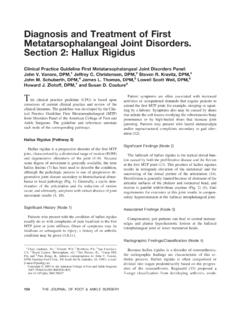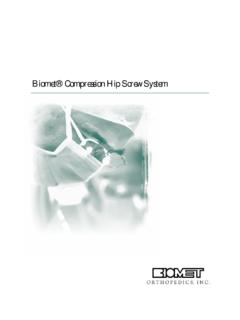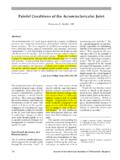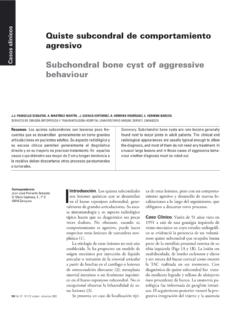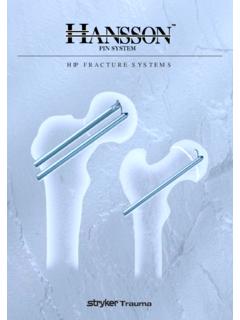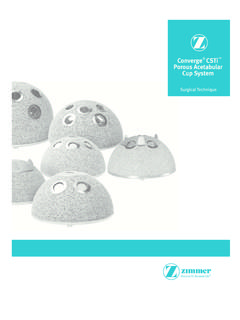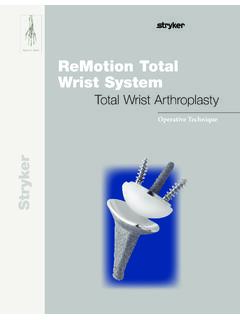Transcription of Diagnosis and Treatment of First …
1 Diagnosis and Treatment of FirstMetatarsophalangeal Joint 2: Hallux RigidusClinical Practice Guideline First metatarsophalangeal Joint Disorders Panel:John V. Vanore, DPM,1 Jeffrey C. Christensen, DPM,2 Steven R. Kravitz, DPM,3 John M. Schuberth, DPM,4 James L. Thomas, DPM,5 Lowell Scott Weil, DPM,6 Howard J. Zlotoff, DPM,7and Susan D. Couture8 This clinical practice guideline (CPG) is based uponconsensus of current clinical practice and review of theclinical literature. The guideline was developed by the Clin-ical Practice Guideline First metatarsophalangeal (MTP)Joint Disorders Panel of the American College of Foot andAnkle Surgeons. The guideline and references annotateeach node of the corresponding Rigidus (Pathway 3)Hallux rigidus is a progressive disorder of the First MTPjoint, characterized by a diminished range of motion (ROM)and degenerative alterations of the joint (1 9).
2 Becausesome degree of movement is generally available, the termhallux limitus (7) has been used to describe the condition,although the pathologic process is one of progressive de-generative joint disease secondary to biomechanical distur-bance or local pathology (Fig. 1). Generally, a cyclic dete-rioration of the articulation and the reduction of motionoccur, and ultimately, ankylosis with virtual absence of jointmovement results (3, 10).Significant History (Node 1)Patients who present with the condition of hallux rigidususually do so with complaints of pain localized to the firstMTP joint or joint stiffness. Onset of symptoms may beinsidious or subsequent to injury; a history of an arthriticcondition may be given (4,8,11).Patient symptoms are often associated with increasedactivities or occupational demands that require patients toextend the First MTP joint; for example, stooping or squat-ting by a laborer.
3 Symptoms also may be caused by shoesthat irritate the soft tissues overlying the subcutaneous bonyprominence or by high-heeled shoes that increase jointjamming. Patients may present with lateral metatarsalgiaand/or suprastructural complaints secondary to gait alter-ation (12).Significant Findings (Node 2)The hallmark of hallux rigidus is the typical dorsal bun-ion caused by both the proliferative disease and the flexionat the First MTP joint (13). This position of hallux equinusresults in retrograde elevation of the metatarsal and theuncovering of the dorsal portion of the articulation (14).Dorsiflexion is generally limited because of abutment of thearticular surfaces of the phalanx and metatarsal head, andmotion is painful with/without crepitus (Fig. 2) (6).
4 Gaitrequirements for extension at this joint results in compen-satory hyperextension at the hallucal interphalangeal Findings (Node 3)Compensatory gait patterns can lead to central metatar-salgia and plantar hyperkeratotic lesions at the hallucalinterphalangeal joint or lesser metatarsal Findings/Classification (Node 4)Because hallux rigidus is a disorder of osteoarthrosis,the radiographic findings are characteristic of this ar-thritic process. Hallux rigidus is often categorized ordivided into stages predominantly based on the progres-sion of the osteoarthrosis. Regnauld (15) proposed a3-stage classification from developing arthrosis, estab-1 Chair, Gadsden, AL;2 Everett, WA;3 Richboro, PA;4 San Francisco,CA;5 Board Liaison, Birmingham, AL;6 Des Plaines, IL;7 Camp Hill,PA; and8 Park Ridge, IL.
5 Address correspondence to: John V. Vanore,DPM, Gadsden Foot Clinic, 306 South 4th St, Gadsden, AL 35901; 2003 by theAmerican College of Foot and Ankle Surgeons1067-2516/03/4203-0003$ JOURNAL OF FOOT & ANKLE SURGERYP athway 3 VOLUME 42, NUMBER 3, MAY/JUNE 2003125lished arthrosis, to ankylosis describing the end-stagejoint disease. Later, a fourth stage was included toaddress the biomechanical imbalance without radio-graphic joint changes (7). This modified 4-stage classifi-cation has been adopted (6,10,16). Therefore, a patientmay present with little to no radiographic jointfindings(stage I) or severe end-stage arthrosis, (stage IV) ( 6).FIGURE 1 Etiology of hallux rigidus. MPJ, metatarsophalangeal 2 Normalfirst MTP joint motion (A) requires initial stability of thefirst metatarsal and subsequent plantarflexion.
6 In the presenceof (B) First ray instability, ROM is restricted with jamming of the base of the proximal phalanx into thefirst metatarsal head and thus initiatingthe degenerative JOURNAL OF FOOT & ANKLE SURGERYI nitial Treatment Options (Node 5)Initial Treatment options are symptom driven (17). Jointpain, capsulitis, or other acute episodic pain may be allevi-ated with the use of nonsteroidal anti-inflammatory drugs(18). Judicious use of corticosteroid injections may providerapid relief, even in recalcitrant joint pain. Modalities thatrelieve inflammation and pain are often Treatment is often an integral componentof initial Treatment . Orthotic management in the treatmentof hallux rigidus should attempt to improve the abnormalpathomechanics or to limit joint motion (12,19,20).
7 Shoemodifications with stiff or rocker-bottom soles or extra-depth shoes may be surgical intervention with performance of jointpreservation procedures may be appropriate in patients withlesser degrees of arthrosis. Although it has not been proven,this may restore function and should be part of the patienteducation Response (Node 6)When nonsurgical care is rendered, the clinical responseis assessed. If the patient is doing well, initial Treatment maybe continued (Node 8). If there has been little or no im-provement or if initial improvement deteriorates, surgicaltreatment is appropriate. If a primary care physician per-formed the initial evaluation and Treatment , referral to apodiatric foot and ankle surgeon is indicated (Node 7).Surgery is considered in patients who continue withsymptoms (Node 7), or simply prefer surgical intervention(Node 7).
8 The surgical Treatment of hallux rigidus will bepredicated on recognition of the condition of the joint as onethat is still salvageable through primary joint reconstructionor one that would be more appropriately treated with ajoint-destructive procedure (Fig. 7).Surgical Treatment : Joint-Salvage ProceduresJoint-preservation procedures usually use cheilectomy byitself or in combination with additional procedures. Theseprocedures include cheilectomy, metatarsal osteotomy, andphalangeal osteotomy. Chondroplasty has also been per-formed as an adjunctive procedure in this is the resection of hypertro-phic bony or osteochondral proliferation along the peripheryof the articulation, which may be restricting joint motion(9,21 37). There is some debate about the appropriateamount of bone that should be resected.
9 All osteophytosisshould be resected from the metatarsal, phalanx, and sesa-moids; some authors advocate aggressive partial joint re-sections (38,39).Metatarsal osteotomy is per-formed to plantarflex thefirst metatarsal, to transpose adistal segment in a plantar direction, to realign the metatar-sal articular surface, or to shorten the metatarsal to achievedecompression (6,7,10,22,40 47). Both distal and proximalosteotomies have been performed for correction of thesedeformities; Figure 13 shows the comparison of the extent of elevatus will determine the anatomic loca-tion of the osteotomy. Distalfirst metatarsal procedures canprovide for plantar displacement of the capital fragment, butto a lesser degree than a proximal osteotomy. Often mod-erate degrees of elevatus can be reduced simply through ajoint decompression procedure (Fig.)
10 8).In cases of significant metatarsus primus elevatus, a prox-imal osteotomy should be considered. These proceduresshould be reserved for rigid or structural deformity, asopposed to positional elevatus. A variety of osteotomieshave also been described to plantarflex thefirst metatarsal,such as the sagittal Z or crescentic osteotomy (30). Alter-natively, the Lapidusfirst metatarsal-cuneiform arthrodesiswith or without a bone graft may be considered (Fig. 9).Phalangeal offirst MTP joint dor-siflexion in patients with hallux rigidus and the presence ofan adequate range of plantarflexion may be addressedthrough phalangeal osteotomy. A dorsal-based wedge os-teotomy within proximal phalanx realigns the toe and re-duces the hallux equinus (7,48 53).A separate category of phalangeal osteotomies ap-proaches the problem from the concept of joint decompres-sion (6,10,30,47,54).
